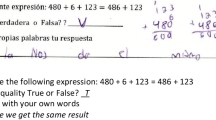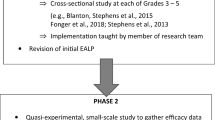Abstract
The purpose of this article is to describe a middle school mathematics teacher’s model of his students’ responses to algebraic tasks involving equivalent expressions and the distributive property. The teacher engaged in two model-eliciting activities designed for teachers by creating a library of his students’ work and an accompanying “Ways of Thinking”[WOT] sheet (Doerr & Lesh, 2003). These activities were designed to help reveal the teachers’ models of students’ algebraic thinking and to promote the development of that model. Results of the analysis showed that the teacher developed a clearer understanding of the role of a variable in algebraic instruction. The teacher employed visual strategies for the first time and began to perceive their usefulness in helping students understand the equivalence of two expressions.
Similar content being viewed by others
References
Attorps, I. (2005).Secondary school teachers’ conceptions about algebra teaching. Paper presented at the Fourth Congress of the European Society for Research in Mathematics Education. Sant Feliu de Guíxols, Spain. Retrieved October 5, 2005, from: http://cerme4.crm.es/Papers%20definitius/12/attorps.pdf
Ball, D. L. (1997). What do students hear? Facing challenges of distance, context, and desire in trying to hear children. In B. Biddle, T. Good, & I. Goodson (Eds.),International handbook of teachers and teaching (Vol. II, pp. 679–818). Boston: Kluwer Academic Publishers.
Bednarz, N. (2001). A problem-solving approach to algebra: Accounting for the reasonings and notations developed by students. In H. Chick, K. Stacey, J. Vincent, & J. Vincent (Eds.),The future of the teaching and learning of algebra.Proceedings of the 12th ICMI Study Conference (pp. 69–78). Melbourne, Australia: The University of Melbourne.
Bednarz, N., Kieran, C., & Lee, L. (1996).Approaches to algebra: Perspectives for research and teaching. Dordrecht, The Netherlands: Kluwer Academic Publishers.
Booth, L. (1988). Children’s difficulties in beginning algebra. In A. Coxford (Ed.),The ideas of algebra, k-12 (pp. 20–32). Reston, VA: National Council of Teachers of Mathematics.
Brenner, M. E., Mayer, R. E., Mosely, B., Brar, T., Duran, R., Reed, B. S., & Webb, D. (1997). Learning by understanding: The role of multiple representations in learning algebra.American Educational Research Journal, 34 (4), 663–689.
Chamberlin, M. T. (2005). Teacher discussions of students’ thinking: Meeting the challenge of attending to students’ thinking.Journal of Mathematics Teacher Education, 8 (2), 141–170.
Chazan, D. (1999). On teachers’ mathematical knowledge and student exploration: A personal story about teaching a technologically supported approach to school algebra.International Journal of Computers for Mathematical Learning, 4 (2–3), 121–149.
Doerr, H. M. (2004). Teachers’ knowledge and the teaching of algebra. In K. Stacey, H. Chick, & M. Kendal (Eds.),The future of the teaching and learning of algebra: The 12th ICMI study (pp. 267–290). Norwood, MA: Kluwer Academic Publishers.
Doerr, H. M. (in press). Examining the tasks of teaching when using students’ mathematical thinking.Educational Studies in Mathematics.
Doerr, H., & Lesh, R. (2003). A modeling perspective on teacher development. In R. Lesh & H. Doerr (Eds.),Beyond constructivism: A models and modeling perspective (pp. 125–140). Mahwah, NJ: Lawrence Erlbaum Associates.
Even, R. (1993). Subject-matter knowledge and pedagogical content knowledge: Prospective secondary teachers and the function concept.Journal for Research in Mathematics Education, 24 (2), 94–116.
Even, R., Tirosh, D., & Robinson, N. (1993). Connectedness in teaching equivalent algebraic expressions: Novice versus expert teachers.Mathematics Education Research Journal, 5 (1), 50–59.
Hiebert, J. (1999). Relationships between research and the NCTM standards.Journal for Research in Mathematics Education, 30 (1), 3–19.
Kaput, J. J. (1987). Towards a theory of symbol use in mathematics. In C. Janvier (Ed.),Problems of representation in the teaching and learning of mathematics (pp. 159–195). Hillsdale, NJ: Erlbaum.
Kaput, J. J. (2000).Teaching and learning a new algebra with understanding. U.S.; Massachusetts: National Center for Improving Student Learning and Achievement in Mathematics and Science Dartmouth MA.
Kieran, C. (1981). Concepts associated with the equality symbol.Educational Studies in Mathematics, 12, 317–326.
Kieran, C. (1992). The learning and teaching of school algebra. In D. Grouws (Ed.),Handbook of research on mathematics teaching and learning (pp. 390–419). New York: Macmillan Publishing Company.
Kieran, C. (2006). Research on the learning and teaching of algebra: A broadening of sources of meaning. In A. Gutiérrez & P. Boero (Eds.),Handbook of research on the psychology of mathematics education: Past, present and future (pp. 11–49). Rotterdam: Sense Publishers.
Küchemann, D. (1981). Algebra. In K. M. Hart (Ed.),Children’s understanding of mathematics: 11–16 (pp. 102–119). London: John Murray.
Langrell, C. W., & Lannin, J. K. (2000). The interplay between instruction and the development of middle school students’ algebraic thinking. In M. L. Fernandez (Ed.),Proceedings of the twenty-second annual meeting of the North America chapter of the International Group for the Psychology of Mathematics Education (pp. 121–126). Columbus, OH: The ERIC Clearinghouse for Science, Mathematics, and Environmental Education.
Lappan, G., Fey, J., Fitzgerald, W., Friel, S., & Phillips, E. (1998).Say it with symbols. White Plains, NY: Dale Seymour Publications.
Lesh, R., Doerr, H., Carmona, G., & Hjalmarson, M. (2003). Mathematical thinking and learning. In R. Lesh & H. Doerr (Eds.),Beyond constructivism: A models and modeling perspective (pp. 125–140). Mahwah, NJ: Lawrence Erlbaum Associates.
Lesh, R., & Kelly, A. (1999). Multi-tiered teaching experiments. In A. Kelly & R. Lesh (Eds.),Handbook of research in mathematics and science education (pp. 197–230). Mahwah, NJ: Lawrence Erlbaum Associates.
Lloyd, G. M., & Wilson, M. (1998). Supporting innovation: The impact of a teacher’s conceptions of functions on his implementation of a reform curriculum.Journal for Research in Mathematics Education, 29 (3), 248–274.
MacGregor, M. (2004). Goals and content of an algebra curriculum for the compulsory years of schooling. In K. Stacey, H. Chick, & M. Kendal (Eds.),The future of the teaching and learning of algebra: The 12th ICMI study (pp. 313–328). Norwood, MA: Kluwer Academic Publishers.
MacGregor, M., & Stacey, K. (1993). Cognitive models underlying students’ formulation of simple linear equations.Journal for Research in Mathematics Education, 24 (3), 217–232.
MacGregor, M., & Stacey, K. (1997). Students’ understanding of algebraic notation: 11-15.Educational Studies in Mathematics, 33, 1–19.
MacGregor, M., & Stacey, K. (1998). Cognitive models underlying algebraic and nonalgebraic solutions to unequal partition problems.Mathematics Education Research Journal, 10 (2), 46–60.
Menzel, B. (2001). Language conceptions of algebra are idiosyncratic. In H. Chick, K. Stacey, J. Vincent, & J. Vincent (Eds.),The future of the teaching and learning of algebra.Proceedings of the 12th ICMI Study Conference (pp. 446–453). Melbourne, The University of Melbourne.
Menzel, B., & Clarke, D. (1998). Teachers interpreting algebra: Teachers’ views about the nature of algebra. In C. Kanes, M. Goos, & E. Warren (Eds.),Teaching mathematics in new times.Proceedings of the 21st annual conference of the Mathematics Education Research Group of Australasia (pp. 365–372). Gold Coast, Qld: MERGA.
Menzel, B., & Clarke, D. (1999). Teacher mediation of student constructions of algebra knowledge. In J. Truran, & K. Truran (Eds.).Making the difference.Proceedings of the 22nd annual conference of the Mathematics Education Research Group of Australasia (pp. 365–372). Sydney: MERGA.
Moskal, B. M., & Magone, M. E. (2000). Making sense of what students know: Examining the referents, relationships and modes students displayed in response to a decimal task.Educational Studies in Mathematics, 43 (3), 313–335.
Nathan, M. J., & Koedinger, K. R. (2000). An investigation of teachers’ beliefs of students’ algebra development.Cognition and Instruction, 18 (2), 209–237.
National Council of Teachers of Mathematics. (2000).Principles and standards for school mathematics. Reston, VA: Author.
Pimm, D. (1987).Speaking mathematically: Communication in mathematics classrooms. London: Routledge & Kegan Paul.
RAND Mathematics Study Panel. (2003).Mathematical proficiency for all students: Toward a strategic research and development program in mathematics education. RAND Mathematics Study Panel. Santa Monica, CA: RAND Corporation. (ERIC Document Reproduction Service No. ED 476 809)
Schifter, D. (1996).What’s happening in math class: Reconstructing professional identities. New York: Teachers College Press.
Schorr, R., & Lesh, R. (2003). A modeling approach for providing teacher development. In R. Lesh & H. Doerr (Eds.),Beyond constructivism: A models and modeling perspective (pp. 141–158). Mahwah, NJ: Lawrence Erlbaum Associates.
Shepard, L. A. (2000). The role of assessment in a learning culture.Educational Researcher, 29 (7), 4–14.
Shulman, L. S. (1986). Those who understand: Knowledge growth in teaching.Educational Researcher, 15 (2), 4–14.
Stacey, K., & MacGregor, M. (2000). Learning the algebraic method of solving problems.Journal of Mathematical Behavior, 18 (2), 149–167.
Strauss, A., & Corbin, J. (1998).Basics of qualitative research: Techniques and procedures for developing grounded theory. Thousand Oaks, California: SAGE Publications, Inc.
Tirosh, D., Even, R., & Robinson, N. (1998). Simplifying algebraic expressions: Teacher awareness and teaching approaches.Educational Studies in Mathematics, 35 (1), 51–64.
Van den Heuvel-Panhuizen, M. (1994). Improvement of (didactical) assessment by improvement of problems: An attempt with respect to percentage.Educational Studies in Mathematics, 27, 341–372.
Warren, E. (2003). The role of arithmetic structure in the transition from arithmetic to algebra.Mathematics Education Research Journal, 15 (2), 122–137.
Author information
Authors and Affiliations
Rights and permissions
About this article
Cite this article
Hallagan, J.E. The case of bruce: A teacher’s model of his students’ algebraic thinking about equivalent expressions. Math Ed Res J 18, 103–123 (2006). https://doi.org/10.1007/BF03217431
Issue Date:
DOI: https://doi.org/10.1007/BF03217431




